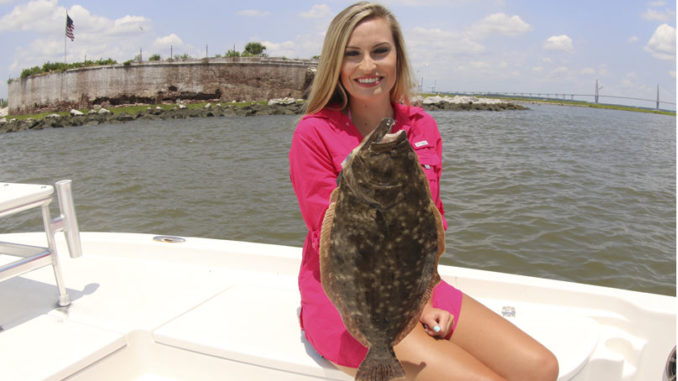
More than 2000 anglers responded to the survey
Last December, SCDNR shared the results of a study that found our region’s southern flounder to be at historically low numbers.
In order to provide state leadership with the best available data, SCDNR staff set out to analyze not just the science of the fishery in South Carolina, but also the perceptions of anglers. We wanted to better understand what anglers were seeing in South Carolina waters, how they fish for flounder, what they value about the species and how they would prefer to see it managed.
In mid-December, we launched a public survey to give folks an opportunity to weigh in on the future of flounder in South Carolina.
Over 2,000 of you responded – with striking results. The average respondent was a South Carolina fishing license holder, with respondents evenly spread across all age groups and geographically across the coast. What was most surprising was the amount of experience represented in the survey takers – a majority of respondents (60%) said they’d been fishing the coast for 20+ years and fished 10+ times a year (80%).
Here is what SCDNR learned
Today, SCDNR is sharing five important findings from the survey results. Read on below.
-
1. The majority of respondents believe South Carolina’s flounder population is in poor or very poor shape.
One of the first questions in the survey was, “What is your perception of the current flounder population?” Most respondents (63%) answered poor or very poor. About 22% of survey takers thought it was average, and less than 10% responded good or very good. These are troubling responses for a state in which flounder is one of the most prized saltwater fish, consistently ranking in the top three most targeted species.
-
2. The majority of respondents said that flounder are fewer and smaller today versus when they started fishing in South Carolina.
We also asked folks how they felt flounder had changed over time. The answers to this would, of course, depend on how long one has been fishing, so it’s significant that a majority of respondents were longtime (20+ years experience) and frequent (10+ fishing trips annually) anglers. Respondents felt that flounder were both less abundant (68%) and the same size (11%) or smaller (51%), which is consistent with what SCDNR’s long-term flounder research has shown.
Vast majority of public want what’s best for the flounder
-
3. Respondents overwhelmingly want to see the flounder population rebuilt over a shorter time period.
An overwhelming number of respondents (85%) indicated they wanted to see the flounder fishery rebuilt in South Carolina. When asked if they would prefer the fishery be rebuilt over a shorter, moderate or longer rebuilding period, 79% of respondents indicated they wanted to see flounder return to a sustainable level on a shorter timeline – despite the fact that a shorter rebuilding period means a greater reduction in the number of fish people can harvest.
-
4. Those polled support all/any management actions necessary to rebuild the population.
The survey also got at folks’ preferences for how to improve flounder numbers. Respondents were presented with a variety of commonly used management tools – lower bag limit, lower boat limit, larger minimum size, a slot limit, a season, and simply whatever biologists think is ‘the best option.’ Lower bag and boat limits were the most popular choices, with the support of 93% and 90% of respondents, respectively, but a majority supported all the options presented.
-
5. Many survey takers expressed concern about gigging.
We received over 1,800 open-ended comments through the survey – and several dominant themes arose when our staff sat down to sort through and categorize those responses. Almost half of all the open-ended responses (44%) referenced a need to address the gig fishery in a meaningful way.
Where do we go from here?
The SCDNR is grateful to all the anglers and concerned citizens who shared their voices and visions for the future of flounder in South Carolina.
SCDNR biologists have identified over a hundred different paths to recovery for flounder. Using sophisticated models that account for the life cycle of flounder and all of the data biologists have collected on the fish in South Carolina, staff are able to predict how different combinations of management tools (such as the above mentioned bag, boat and slot limits, minimum size, and different seasons) would impact the flounder population – and thus how quickly they would recover to levels determined to be sustainable in the original flounder study.
At this point, the agency’s Marine Advisory Committee, and then the SCDNR Board, may consider the work presented by staff and make an official recommendation for addressing declining flounder numbers.
South Carolina is a state in which changes to fish and game laws are made by the South Carolina Legislature – proposed changes must be introduced and approved in both the House and Senate and signed by the Governor before taking effect. This means change can be a lengthy process, but SCDNR staff feel confident we’re providing lawmakers with the best available science to guide the regulatory process.
In the meantime, some members of the fishing community have already begun taking action on their own. Multiple coastal fishing tournaments are considering whether to temporarily remove flounder as a target species, and some local anglers have made a point to limit the number of flounder that they keep.
–E. Weeks, SCDNR


Be the first to comment